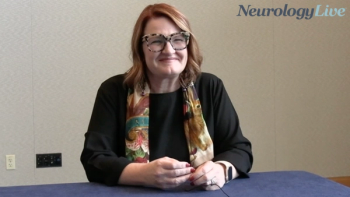
Neuro News Roundup: ALS Awarness Month
In honor of ALS Awareness Month, held May 2023, get caught up on some of the latest news in amyotrophic lateral sclerosis as the NeurologyLive® team shares some of our data updates.
In recent months, the NeurologyLive® team has been covering the news on the latest updates in the clinical care of individuals with neuromuscular disorders, multiple sclerosis, movement disorders, sleep disorders, and more.
For ALS Awareness Month — May 2023 —the team has culminated some of the biggest pieces of news to offer updates on new developments in literature in ALS to spread awareness on the prevention and treatment the neuromuscular disease.
Latest Literature
Dosing Begins for Phase 1 Study of Cell Therapy CK0803 in ALS
According to an announcement from Cellenkos, the first patient has been dosed in its phase 1 safety run-in study assessing its investigational T regulatory (Treg) cell therapy CK0803 in amyotrophic lateral sclerosis (ALS).1
Also known as REGALS (NCT05695521), the phase 1 study includes a safety run-in study of 6 individuals with ALS, followed by a phase 1b randomized comparative trial with in an additional 60 patients with the disease. The double-blind portion consists of 2 stages, each including 30 patients, with a safety rule applied after stage 1 that allows for early termination of the study. The phase 1 study will be geared to establish safety and tolerability of multiple doses of CK0803 in ALS, while the phase 1b portion will provide preliminary efficacy data on the agent.
CK0803 is a novel allogenic cell therapy consisting of Tregs that is derived from clinical-grade umbilical cord blood units and manufactured using Cellenkos’ proprietary CRANE process. Doses of the agent, which require no HLA or ABO matching, can be manufactured from a single umbilical cord unit, where the final cryopreserved product is readily available for use, at the point of care. In the study, induction dosing of CK0803 includes 1 infusion every 7 days for 4 doses, while consolidation dosing includes 1 infusion every 28 days for 5 doses.
In the phase 1b study, investigators will focus on clinical outcomes such as survival time and change in ALS Functional Rating Scale-Revised (ALSFRS-R), as well as secondary end points of neurofilament light chain levels in serum and cerebrospinal fluid over time. Other secondary outcomes include handheld dynamometer, a measure of muscle strength, and ventilation assistance-free survival.
ALS Agent SAR443820 Shows High CNS Penetration, Promising Safety Profile in Phase 1 Study
Findings from the first-in-human phase 1 study assessing SAR443820 (Sanofi), an oral RIPK1 inhibitor in development for amyotrophic lateral sclerosis (ALS) and multiple sclerosis (MS), showed potential central nervous system (CNS) penetrance in healthy participants, with a safety profile that is safe and well-tolerated.2
In a multi-cohort trial, SAR44380, previously known as DNL788, was well-tolerated with no treatment-related serious adverse events (AEs) or permanent treatment discontinuation. The most common AEs identified were dizziness and headache. Presented at the
The study included several groups of patients, and was split in Part 1 and 2. In Part 1a, 4 cohorts (n = 8 each; SAR443820: n = 6; placebo = 2) who received single-ascending doses of the active therapy or placebo, while Part 1b included 2 single-dose cohorts (n = 6 each) who received the lowest and 4-fold the lowest doses of SAR443820. In Part 2, 4 cohorts (n = 10 each; SAR443820: n = 8; placebo: n = 2) received 14-day SAR443820 or placebo in multiple-ascending doses.
Results showed no major deviations from dose proportionality for maximum concentration (Cmax) and area under the curve over the range of SAR443820 doses. For the single-ascending dose and multiple ascending dose cohorts, mean plasma half-lives ranged between 6-8 hours and 7-9 hours, respectively. Investigators noted that the mean cerebrospinal fluid-to-unbound plasma concentration ratio suggests high CNS-penetrance. Across all SAR443820 groups, target engagement was reached, reflected by maximum median inhibition of phosphorylated-Ser166-RIPK1 levels.
ALS Agent NP001 Becomes First to Link Regulation of Innate Immune System With Respiratory Function
New data from a previously conducted phase 2 study of NP001 (Neuvivo), an investigational regulator of innate immune function, showed that C-reactive protein (CRP) levels in patients with ALS correlated with lung function. Importantly, plasma TGFB1, a dominant regulator of inflammation, was 95% higher after 6 months in high CRP-treated patients relative to controls, suggesting the therapy may have acted in part to reset the innate immune system.3,4
Previous research has shown that CRP plays an important role in the body clearing misfolded proteins, dying cells, and infectious agents as part of a normal innate immune system response. In accordance with FDA guidance published in 2019, the new analysis stratified and defined patients as high CRP (>1.13 mg/L; n = 75) or low CRP (<1.13 mg/L; n = 50). Following this, findings showed a 64% slower rate of vital capacity (VC) decline in patients with high CRP compared with placebo (P = .05) and those with low CRP, who showed no response.
All ALS baseline values were similar between treated and controls except for those older than 65 years who were excluded from the analysis. While those with low baseline CRP saw no change in VC over time regardless of treatment status, patients with high CRP on placebo lost an average of 2.1% VC per month. In comparison, those on NP001 with high CRP lost 0.75% VC per month. By age, there were no significant differences found between placebo and 2 mg/kg NP001 treated in both high and low CRP groups.
In patients with ALS less than 65 years, investigators found a positive linear relationship between plasma levels of the acute phase reactant serum amyloid A (SAA), a factor related to innate immune system regulation, and high CRP at baseline (R2 = 0.25; P = .004). This confirmed that the immune activation in patients with high CRP is not isolated, but a component of a generalized acute phase reaction.
First-Ever Study of STATHMIN-2 Therapy in ALS Commences
According to a recent announcement, patient dosing has begun for the phase 1 ANQUR study (NCT05633459) assessing QRL-201 (QurAlis), an investigational agent designed to restore STATHMIN-2 (STMN2) expression in patients with ALS. STATHMIN-2 has been shown to be highly expressed in human motor neurons, the cells that primarily degenerate in ALS.5
ANQUR, a multi-center, randomized, double-blind, placebo-controlled multiple ascending dose study, is the first to assess a therapy that rescues STMN2 expression in patients with ALS. In total, 8 cohorts of 8 participants each, will be randomly assigned 6:2 to either QRL-201 or placebo. The primary outcome is safety, assessed by number of treatment-emergent adverse events, with secondary outcomes evaluating pharmacokinetics in plasma.
STATHMIN-2 is a well-known protein important for neural repair and axonal stability, the expression of which is significantly decreased in a majority of patients with ALS. Additionally, previous research has shown that patients with the disease almost universally display pathological mislocalization of the RNA-binding protein TDP-43 and that mutations in its gene cause familial forms of ALS. In 2019, QurAlis co-founder Kevin Eggan, PhD, discovered that the expression of STMN2, which encodes a microtubule regulator, declined after TDP-43 knockdown and TDP-43 mislocalization as well as in patient-specific motor neurons and postmortem patient spinal cords.6
Milestone-Free Time Longer in IV Edaravone-Treated Patients With ALS, Administrative Claims Suggest
Findings from a real-world analysis of administrative claims of patients with ALS showed that those treated with intravenous (IV) edaravone (Radicava; MT Pharma) demonstrated longer milestone-free time and had fewer reported deaths than patients with ALS not treated with the agent.7
The study included 360 IV edaravone-treated patients with ALS and 360 non-IV edaravone-treated patients with ALS who were matched on several covariates. Presented at the 2023 Muscular Dystrophy Association (MDA) Clinical and Scientific Conference, held March 19-22, in Dallas, Texas, the study included milestones of canes/walkers/wheelchairs (M1), artificial nutrition (M2), noninvasive ventilation (M3), invasive ventilation (M4), speech-generating devices (M5), and hospice (M6).
Cases and controls had similar mean ages, and were matched on other covariates such as race, geographic region, gender, pre-index disease duration, insurance, cardiovascular disease history, riluzole prescription, gastrostomy tube placement, artificial nutrition, non-invasive ventilation, and all-cause hospitalization. Median treatment duration in the IV edaravone-treated group was 9.11 (IQR, 3.45-16.08) months. At baseline, the proportion of claims for bulbar-, limb-, nerve-, and respiratory-related symptoms were similar between the groups.
The data, pulled from 2017 to 2021, showed that more IV edaravone-treated cases reported an absence of milestones than non-IV edaravone-treated controls from 0-12 months after the index date. Additionally, fewer deaths occurred in the IV edaravone group than controls from 0-12 months and 12-24 months after the index date. Combined with data from the pivotal phase 3 trial, Study 19 (NCT01492686), which showed that treatment with edaravone slowed loss of physical function by 33%, these results provide an example of real-world impact of the medication, the study authors concluded.
Differences between the 2 groups in cause-specific restricted mean time lost (RMTL) was estimated to examine the benefit of IV edaravone while considering mortality as the competing risk. In the post-index period, differences in RMTL in months indicated longer milestone-free time in cases than controls (M1: 2.50 [IQR, 0.93-4.07]; M2: 4.30 [IQR, 2.88-5.72]; M3: 2.92 [IQR, 1.56-4.28]; M4: 0.92 [IQR, 0.25-1.58]; M5: 3.37 [IQR, 2.27-4.46]; M6: 2.33 [IQR, 1.31-3.34]). For the majority of reported milestones, IV edaravone-treated cases had longer milestone-free time than non-IV treated controls for both commercial and Medicare Advantage insurance.
REFERENCES
1. Cellenkos announces first patient dosed with CK0803 cell therapy for treatment of amyotrophic lateral sclerosis. News release. May 2, 2023. Accessed May 3, 2023. https://www.prnewswire.com/news-releases/cellenkos-announces-first-patient-dosed-with-ck0803-cell-therapy-for-treatment-of-amyotrophic-lateral-sclerosis-301812682.html
2. Hincelin-Mary A, Lewanczk P, Cantalloube C, et al. First-in-human study of safety, tolerability, pharmacokinectics, and pharmacodynamics of SAR443820, a central nervous system penetrant RIPK1 inhibitor in healthy participants. Presented at: 2023 AAN Annual Meeting; April 22-27; Boston, MA. Abstract 001927
3. New study of Neuvivo’s NP001 is first to link regulation of the innate immune system with respiratory function in ALS patients. News release. Neuvivo. March 30, 2023. Accessed April 12, 2023. https://www.prnewswire.com/news-releases/new-study-of-neuvivos-np001-is-first-to-link-regulation-of-the-innate-immune-system-with-respiratory-function-in-als-patients-301785352.html
4. McGrath MS, Zhang R, Bracci PM, Azhir A, Forrest BD. Regulation of the innate immune system as a therapeutic approach to supporting respiratory function in ALS. Cells. 2023;12(7). doi:10.3390/cells12071031
5. QurAlis announces first patient dosed with QRL-201, a first-in-class STATHMIN-2 precision therapy for ALS. News release. April 6, 2023. Accessed April 11, 2023. https://www.prnewswire.com/news-releases/quralis-announces-first-patient-dosed-with-qrl-201-a-first-in-class-stathmin-2-precision-therapy-for-als-301790444.html
6. Klim JR, Williams LA, Limone F, et al. ALS-implicated protein TDP-43 sustains levels of STMN2, a mediator of motor neuron growth and repair. Nature Neuroscience. 2019;22:167-179. doi:10.1038/s41593-018-0300-4
7. Ciepielewska M, Berry J, Hagan M, Zhang J, Liu Y. Longer milestone-free time to IV edaravone-treated vs IV edaravone-naïve amyotrophic lateral sclerosis patients: an administrative claims analysis. Presented at: 2023 MDA Clinical and Scientific Conference; March 19-22; Abstract 174.
Newsletter
Keep your finger on the pulse of neurology—subscribe to NeurologyLive for expert interviews, new data, and breakthrough treatment updates.


































